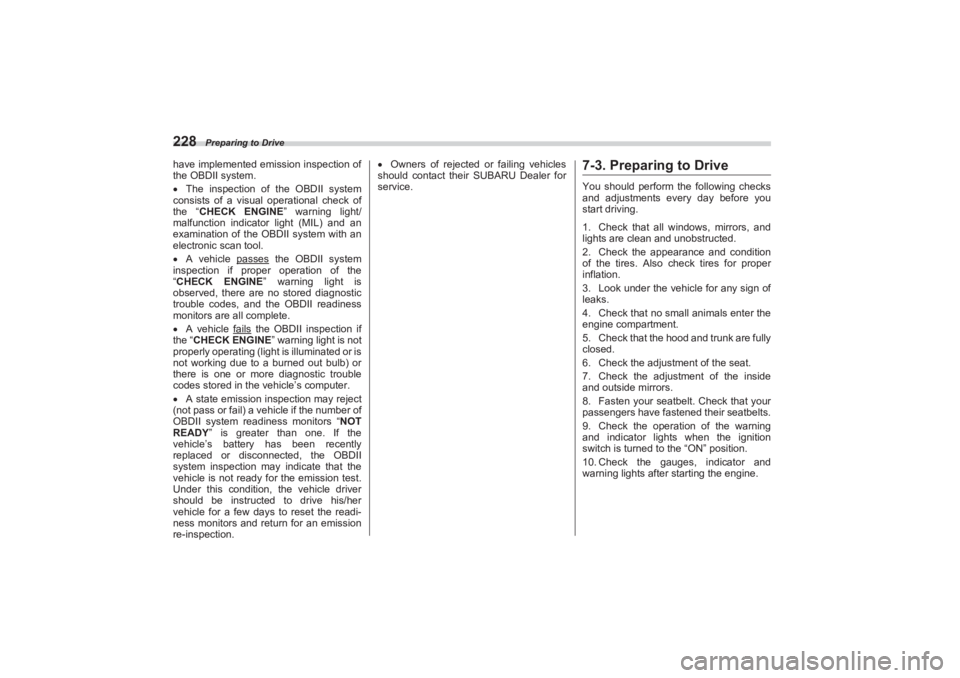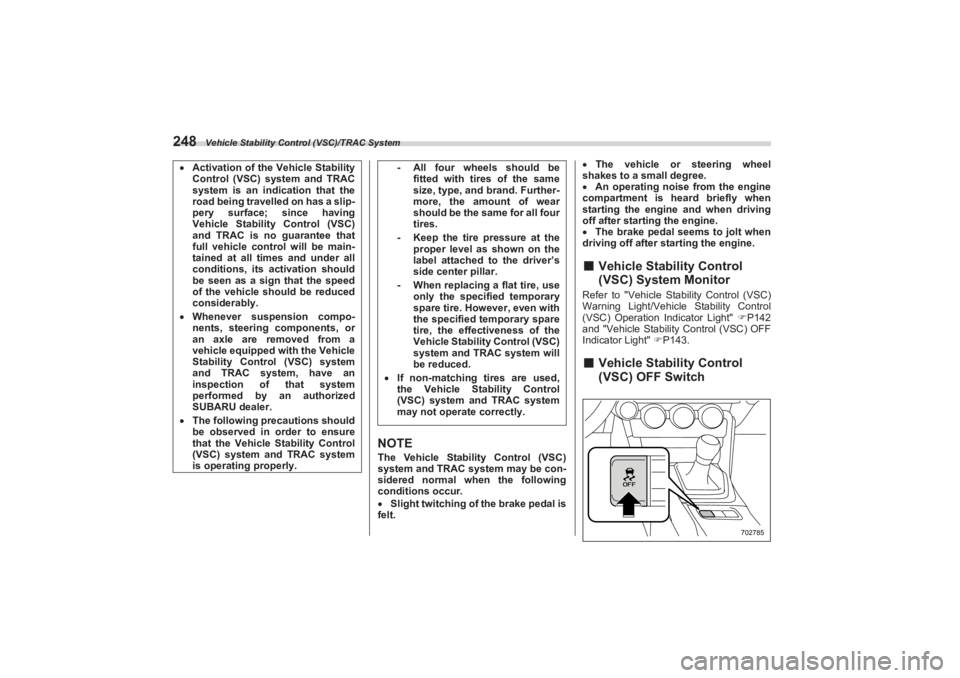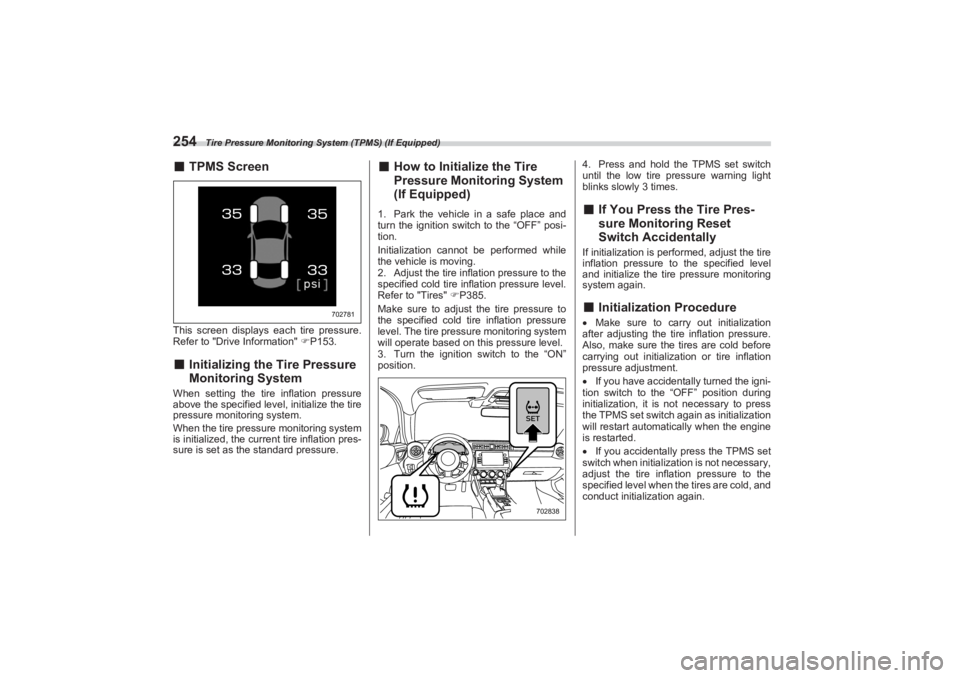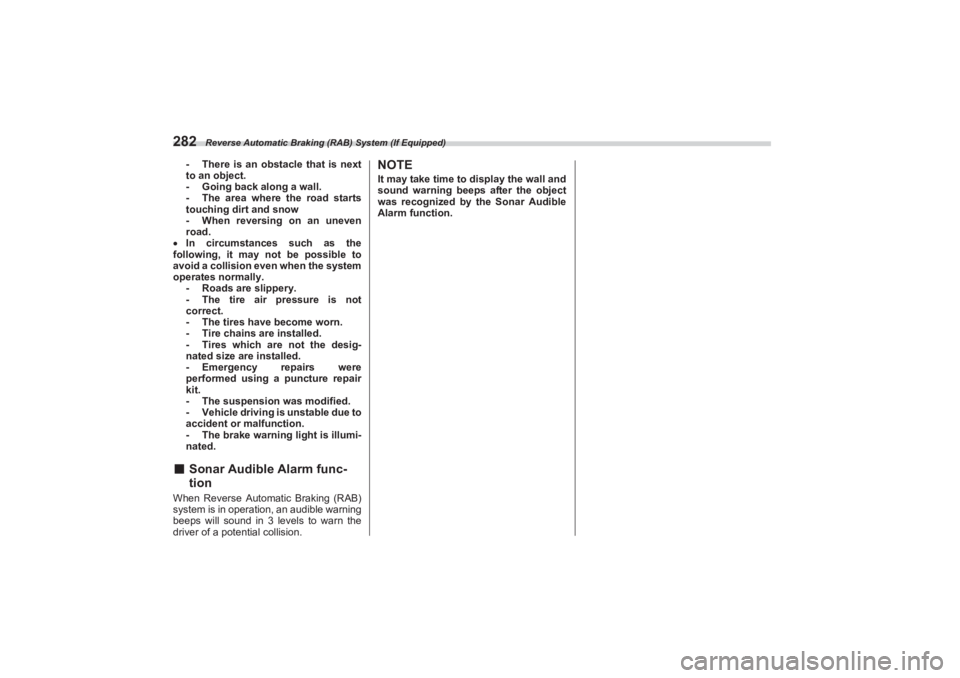2023 SUBARU BRZ tires
[x] Cancel search: tiresPage 177 of 432

Center Information Display (CID)
171
Instruments and Controls3
– CONTINUED –
5.→“Add”
6. Enter the name.
7. →“Next” 8. Enter the date.
9.
→“OK”
NOTEA maximum of 5 birthdays can be
stored.
▽ Anniversary List
The procedure for setting an anniversary
is the same as "Birthday List" P170,
except that in step 4 “Anniversary List” is
selected. ▼
Maintenance
Maintenance reminders can be set.
Engine oil setting:
1. Touch (Maintenance).
2.→ (Engine Oil)
3. Select “Notificatio n Date” or “Notifica-
tion Distance” of the reminder.
4. →“Set”
5. →
Oil Filter setting:
The setting procedure is the same as
“Engine Oil” setting, but touch the “Oil
Filter” item in step 2.
Tires setting:
The setting procedure is the same as
“Engine Oil” setting, but touch the “Tires”
item in step 2.
306999307000
307001
XXXX
306164
BRZ_U.book 171 ページ 2022年3月29日 火曜日 午後3時59分
Page 234 of 432

Preparing to Drive
228have implemented emission inspection of
the OBDII system.
The inspection of the OBDII system
consists of a visual operational check of
the “ CHECK ENGINE ” warning light/
malfunction indicator light (MIL) and an
examination of the OBDII system with an
electronic scan tool.
A vehicle passes
the OBDII system
inspection if proper operation of the
“ CHECK ENGINE ” warning light is
observed, there are no stored diagnostic
trouble codes, and the OBDII readiness
monitors are all complete.
A vehicle fails
the OBDII inspection if
the “ CHECK ENGINE ” warning light is not
properly operating (light is illuminated or is
not working due to a burned out bulb) or
there is one or more diagnostic trouble
codes stored in the vehicle’s computer.
A state emission in spection may reject
(not pass or fail) a vehicle if the number of
OBDII system readiness monitors “ NOT
READY ” is greater than one. If the
vehicle’s battery has been recently
replaced or disconnected, the OBDII
system inspection may indicate that the
vehicle is not ready for the emission test.
Under this condition, the vehicle driver
should be instructed to drive his/her
vehicle for a few days to reset the readi-
ness monitors and return for an emission
re-inspection.
Owners of rejected or failing vehicles
should contact their SUBARU Dealer for
service.
7-3. Preparing to DriveYou should perform the following checks
and adjustments every day before you
start driving.
1. Check that all windows, mirrors, and
lights are clean and unobstructed.
2. Check the appearance and condition
of the tires. Also check tires for proper
inflation.
3. Look under the vehicle for any sign of
leaks.
4. Check that no small animals enter the
engine compartment.
5. Check that the hood and trunk are fully
closed.
6. Check the adjustment of the seat.
7. Check the adjustment of the inside
and outside mirrors.
8. Fasten your seatbelt. Check that your
passengers have fastened their seatbelts.
9. Check the operation of the warning
and indicator lights when the ignition
switch is turned to the “ON” position.
10. Check the gauges, indicator and
warning lights after starting the engine.
BRZ_U.book 228 ページ 2022年3月29日 火曜日 午後3時59分
Page 253 of 432

Vehicle Stability Control (VSC)/TRAC System
247
Starting and Operating7
– CONTINUED –
7-13. Vehicle Stability Control (VSC)/TRAC System■Vehicle Stability Control
(VSC) SystemIn the event of wheelspin and/or skidding
on a slippery road surface and/or during
cornering and/or an evasive maneuver,
the Vehicle Stability Control (VSC) system
adjusts the engine’s output and the
wheels’ respective braking forces to help
maintain traction and directional control.
The skid suppression function is designed
to help maintain directional stability by
suppressing the wheels’ tendency to slide
sideways during steering operations. Acti-
vation of this function is indicated by
flashing of the Vehicle Stability Control
(VSC) operation indicator light.NOTE In the following circumstances, the
vehicle may be less stable than it feels
to the driver. The Vehicle Stability
Control (VSC) system may therefore
operate. Such operation does not indi-
cate a system malfunction. - On gravel-covered or rutted
roads
- On unfinished roads
- When the vehicle is fitted with
snow tires or winter tires
Activation of the Vehicle Stability
Control (VSC) system will cause opera-
tion of the steering wheel to feel
slightly different compared to that for
normal conditions.
It is always important to reduce
speed when approaching a corner,
even if the vehicle is equipped with
Vehicle Stability Control (VSC) system.
Always turn off the engine before
replacing a tire as failure to do so may
render the Vehicle Stability Control
(VSC) system unable to operate
correctly.
■ TRAC SystemThe TRAC system is designed to prevent
spinning of the driving wheels on slippery
road surfaces, thereby helping to maintain
traction and directional control. Activation
of this function is indicated by flashing of
the Vehicle Stability Control (VSC) opera-
tion indicator light. The TRAC system is
also equipped with the brake LSD func-
tion.
WARNING
Directional control and power
may not be achievable while
driving on slippery road surfaces,
even if the TRAC system is oper-
ating. Do not drive the vehicle in
conditions where stability and
power may be lost. Always use the utmost care in
driving – overconfidence
because you are driving with a
Vehicle Stability Control (VSC)
system and TRAC system
equipped vehicle could easily
lead to a serious accident.
CAUTION
Even if your vehicle is equipped
with Vehicle Stability Control
(VSC) system and TRAC system,
winter tires should be used when
driving on snow-covered or icy
roads; in addition, vehicle speed
should be reduced considerably.
Simply having a Vehicle Stability
Control (VSC) system and TRAC
system does not guarantee that
the vehicle will be able to avoid
accidents in any situation.
BRZ_U.book 247 ページ 2022年3月29日 火曜日 午後3時59分
Page 254 of 432

Vehicle Stability Control (VSC)/TRAC System
248
NOTEThe Vehicle Stability Control (VSC)
system and TRAC system may be con-
sidered normal when the following
conditions occur.
Slight twitching of the brake pedal is
felt.
The vehicle or steering wheel
shakes to a small degree.
An operating noise from the engine
compartment is heard briefly when
starting the engine and when driving
off after starti ng the engine.
The brake pedal seems to jolt when
driving off after st arting the engine.
■Vehicle Stability Control
(VSC) System MonitorRefer to "Vehicle Stability Control (VSC)
Warning Light/Vehicle Stability Control
(VSC) Operation Indicator Light" P142
and "Vehicle Stability Control (VSC) OFF
Indicator Light" P143.■ Vehicle Stability Control
(VSC) OFF Switch
Activation of the Vehicle Stability
Control (VSC) system and TRAC
system is an indication that the
road being travelled on has a slip-
pery surface; since having
Vehicle Stability Control (VSC)
and TRAC is no guarantee that
full vehicle control will be main-
tained at all times and under all
conditions, its activation should
be seen as a sign that the speed
of the vehicle should be reduced
considerably. Whenever suspension compo-
nents, steering components, or
an axle are removed from a
vehicle equipped with the Vehicle
Stability Control (VSC) system
and TRAC system, have an
inspection of that system
performed by an authorized
SUBARU dealer. The following precautions should
be observed in order to ensure
that the Vehicle Stability Control
(VSC) system and TRAC system
is operating properly.
- All four wheels should be
fitted with tires of the same
size, type, and brand. Further-
more, the amount of wear
should be the same for all four
tires.- Keep the tire pressure at the
proper level as shown on the
label attached to the driver’s
side center pillar.- When replacing a flat tire, use
only the specified temporary
spare tire. However, even with
the specified temporary spare
tire, the effectiveness of the
Vehicle Stability Control (VSC)
system and TRAC system will
be reduced.
If non-matching tires are used,
the Vehicle Stability Control
(VSC) system and TRAC system
may not operate correctly.
702785
BRZ_U.book 248 ページ 2022年3月29日 火曜日 午後3時59分
Page 258 of 432

Tire Pressure Monitoring System (TPMS) (If Equipped)
252
WARNING
If the low tire pressure warning
light illuminates while driving,
never brake suddenly. Instead,
perform the following procedure.
Otherwise an accident involving
serious vehicle damage and
serious personal injury could
occur.
(1) Keep driving straight ahead
while gradually reducing
speed.(2) Slowly pull off the road to a
safe place.(3) Check the pressure for all
four tires and adjust the pres-
sure to the COLD tire pres-
sure shown on the tire
inflation pressure label on the
center pillar on the driver’s
side.
Even when the vehicle is driven a
very short distance, the tires get
warm and their pressures
increase accordingly. Be sure to
let the tires cool thoroughly
before adjusting their pressures
to the standard values shown on
the tire inflatio n pressure label.
Refer to "Tires and Wheels"
P358. The tire pressure moni-
toring system does not function
when the vehicle is stationary.
After adjusting the tire pressures,
increase the vehicle speed to at
least 25 mph (40 km/h) to start the
TPMS rechecking of the tire infla-
tion pressures. If the tire pres-
sures are now above the severe
low pressure threshold, the low
tire pressure warning light should
turn off a few minutes later.
If this light still illuminates while
driving after adjusting the tire
pressure, a tire may have signifi-
cant damage and a fast leak that
causes the tire to lose air rapidly.
For details, refer to "Flat Tires"
P303.
When a spare tire is mounted or a
wheel rim is replaced without the
original pressure sensor/trans-
mitter being transferred, the low
tire pressure warning light will
illuminate steadily after blinking
for approximately one minute.
This indicates the TPMS is unable
to monitor all fo ur road wheels.
Contact your SUBARU dealer as
soon as possible for tire and
sensor replacement and/or
system resetting.
BRZ_U.book 252 ページ 2022年3月29日 火曜日 午後3時59分
Page 259 of 432

Tire Pressure Monitoring System (TPMS) (If Equipped)
253
Starting and Operating7
– CONTINUED –
■Certification for the ReceiverFCC ID: HYQ23ABGNOTEThis device complies with part 15 of
the FCC Rules. Operation is subject to
the following two conditions: (1) This
device may not cause harmful interfer-
ence, and (2) this device must accept
any interference received, including
interference that may cause unde-
sired operation.
FCC WARNING
Changes or modifications not
expressly approved by the party
responsible for compliance could void
the user’s authority to operate the
equipment.
■ Certification for the Trans -
mitter U.S.-spec. models
FCC ID: PAXPMVE000NOTEThis device complies with part 15 of
the FCC Rules. Operation is subject to
the following two co nditions: (1) This
device may not cause harmful interfer-
ence, and (2) this device must accept
any interference received, including
interference that may cause unde-
sired operation.
FCC WARNING
Changes or modifications not
expressly approved by the party
responsible for compliance could void
the user’s authority to operate the
equipment.
Mexico-spec. models
MEX: RLVPAPM17-1337
When a tire is repaired with liquid
sealant, the tire pressure warning
valve and transmitter may not
operate properly. If a liquid
sealant is used, contact your
nearest SUBARU dealer or other
qualified service shop as soon as
possible. Make sure to replace
the tire pressure warning valve
and transmitter when replacing
the tire. You may reuse the wheel
if there is no damage to it and if
the sealant residue is properly
cleaned off. Do not inject any tire
liquid or aerosol tire sealant into
the tires, as this may cause a
malfunction of the tire pressure
sensors. If the light illuminates
steadily after blinking for approx-
imately one minute, promptly
contact a SUBARU dealer to have
the system inspected.
CAUTION
Do not place metal film or any metal
parts under the driver’s seat. This
may cause poor reception of the
signals from the tire pressure sen-
sors, and the tire pressure monitor-
ing system will not function
properly.
BRZ_U.book 253 ページ 2022年3月29日 火曜日 午後3時59分
Page 260 of 432

Tire Pressure Monitoring System (TPMS) (If Equipped)
254■TPMS ScreenThis screen displays ea ch tire pressure.
Refer to "Drive Information" P153.■ Initializing the Tire Pressure
Monitoring SystemWhen setting the tire inflation pressure
above the specified level, initialize the tire
pressure monitoring system.
When the tire pressure monitoring system
is initialized, the current tire inflation pres-
sure is set as the standard pressure.
■ How to Initialize the Tire
Pressure Monitoring System
(If Equipped)1. Park the vehicle in a safe place and
turn the ignition switch to the “OFF” posi-
tion.
Initialization cannot be performed while
the vehicle is moving.
2. Adjust the tire infl ation pressure to the
specified cold tire inflation pressure level.
Refer to "Tires" P385.
Make sure to adjust the tire pressure to
the specified cold tire inflation pressure
level. The tire pre ssure monitoring system
will operate based on this pressure level.
3. Turn the ignition switch to the “ON”
position. 4. Press and hold the TPMS set switch
until the low tire pressure warning light
blinks slowly 3 times.
■ If You Press the Tire Pres -
sure Monitoring Reset
Switch AccidentallyIf initialization is perf ormed, adjust the tire
inflation pressure to the specified level
and initialize the tire pressure monitoring
system again.■ Initialization ProcedureMake sure to carry out initialization
after adjusting the tire inflation pressure.
Also, make sure the tires are cold before
carrying out initialization or tire inflation
pressure adjustment.
If you have accidentally turned the igni-
tion switch to the “OFF” position during
initialization, it is not necessary to press
the TPMS set switch again as initialization
will restart automatically when the engine
is restarted.
If you accidentally press the TPMS set
switch when initialization is not necessary,
adjust the tire inflation pressure to the
specified level when the tires are cold, and
conduct initialization again.
702781
702838
BRZ_U.book 254 ページ 2022年3月29日 火曜日 午後3時59分
Page 288 of 432

Reverse Automatic Braking (RAB) System (If Equipped)
282
- There is an obstacle that is next
to an object.
- Going back along a wall.
- The area where the road starts
touching dirt and snow
- When reversing on an uneven
road.
In circumstances such as the
following, it may not be possible to
avoid a collision even when the system
operates normally. - Roads are slippery.
- The tire air pressure is not
correct.
- The tires have become worn.
- Tire chains are installed.
- Tires which are not the desig-
nated size are installed.
- Emergency repairs were
performed using a puncture repair
kit.
- The suspension was modified.
- Vehicle driving is unstable due to
accident or malfunction.
- The brake warning light is illumi-
nated.
■ Sonar Audible Alarm func -
tionWhen Reverse Automatic Braking (RAB)
system is in operation, an audible warning
beeps will sound in 3 levels to warn the
driver of a potential collision.
NOTEIt may take time to display the wall and
sound warning beeps after the object
was recognized by the Sonar Audible
Alarm function.
BRZ_U.book 282 ページ 2022年3月29日 火曜日 午後3時59分